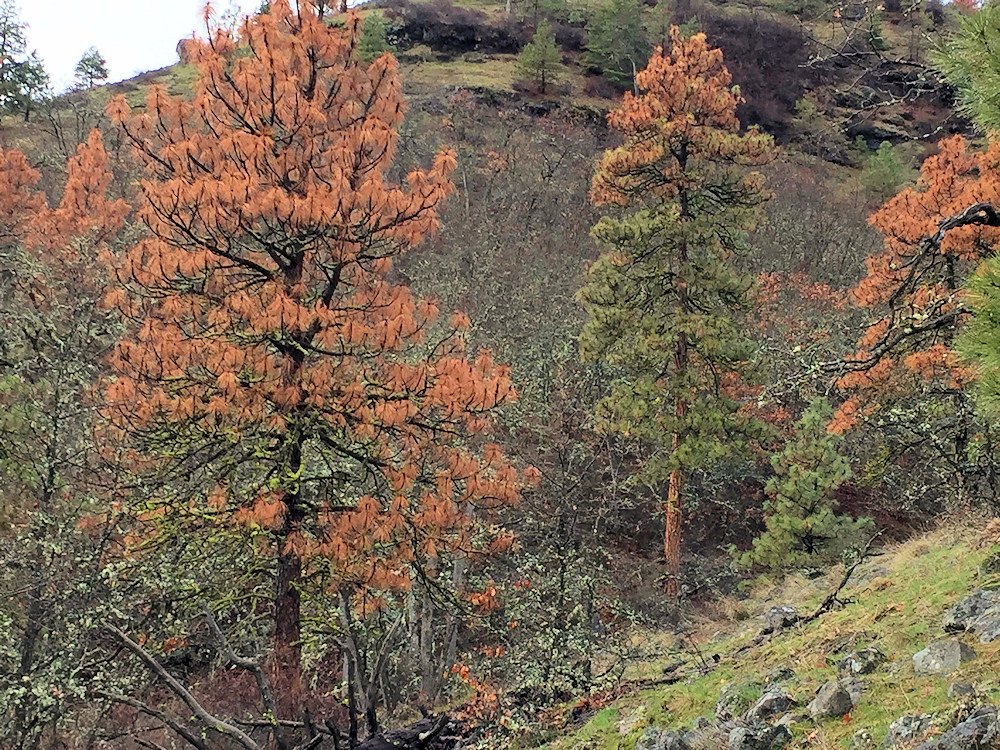Amid fire damage and drought, Oregon trees’ next nemesis: Bark beetles

Oregon Dept. of Forestry offers advice to landowners about native pests
SALEM, Ore. (KTVZ) – Many of the trees damaged by Oregon's Labor Day wildfires last year may face a new threat in the form of tree-killing beetles, which emerged in April, looking for new homes.
Oregon Department of Forestry Forest Entomologist Christine Buhl warns that fire-injured trees can attract bark beetles, which lay their eggs under the bark. When the larvae hatch, they begin feeding on the tree, destroying the tissues needed to send water from the roots to the needles and return nutrients.
The two main culprits, both of which are native to Oregon, are:
- Douglas-fir beetle, which attacks and kills large-diameter Douglas-fir
- Ips beetles, some of which are lethal to small-diameter pines, including ponderosa, lodgepole, sugar and western white pine, as well as introduced pines
“These two beetles do not attack trees that are already dead," Buhl said, "but they will readily go after living trees that have been weakened by drought, storms or by being scorched or partly charred in a wildfire.”
If enough fire-injured or drought-weakened trees are available, populations of either beetle can in a year or two build up enough numbers that they can overwhelm the defenses of a healthier tree.
“Not every fire-injured stand may experience an uptick in infestation, and not every infestation will spread to healthy trees,” Buhl points out. “But the likelihood is greater when otherwise healthy trees are already struggling due to prior stress, such as drought. This is especially true on poor sites with thin or compacted soils, sun-soaked south-facing slopes, or former farmlands converted to woodlots.”
Forest landowners concerned about beetles should look for brown frass – sawdust-like piles dug out of trees by the insects. Ips, however, tend to damage smaller diameter portions of pines (tops, branches), which can make it hard to recognize an infestation until treetops begin to die. By the time trees are dying, beetles may have moved on to other trees nearby so check those, advises Buhl. Infested trees will usually die within a year or less.
Landowners can remove beetle-infested trees early to reduce the risk of a larger outbreak, taking care in pine stands to burn or chip pine that’s 3 to 8 inches in diameter. “From April through September Ips beetles can infest pine slash. So if you can’t burn or chip slash it is best to wait till just after fire season in late October or November to limb up pine trees or conduct operations that create pine slash,” Buhl recommends.
She said landowners who want to forestall an outbreak of Douglas-fir beetle next spring might want to review their situation with a specialist (ODF stewardship forester, ODF entomologist, OSU Forestry Extension) to determine the health of their stand and infestation levels.
Based on the review, it might be recommended that they consider buying the beetle pheromone repellant MCH. If applied in March, MCH discourages this beetle from gathering and attacking trees en masse when they emerge in April from their winter homes.
For more information about insects that affect forest trees visit https://www.oregon.gov/odf/forestbenefits/pages/foresthealth.aspx